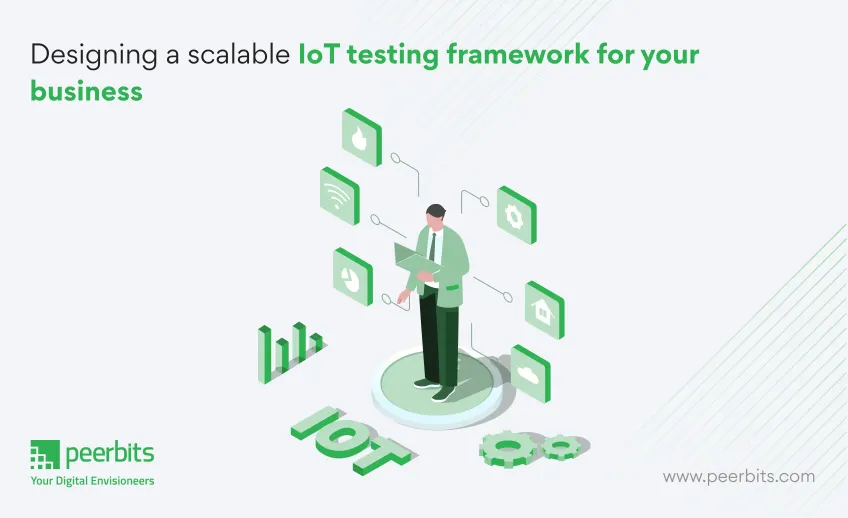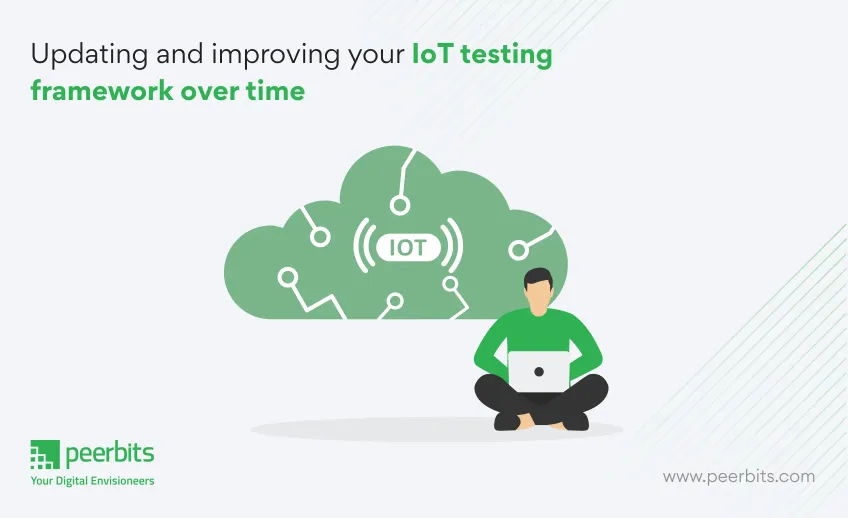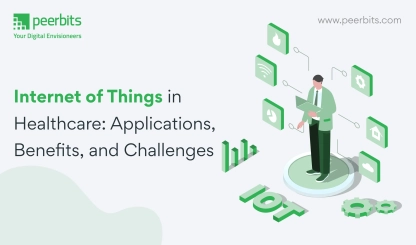The Internet of Things (IoT) has changed the way industries operate by connecting devices, systems, and users in ways that were previously unimaginable. From healthcare and agriculture to manufacturing and smart homes, IoT applications are redefining efficiency and innovation.
As businesses increasingly adopt IoT, the need for reliable and high-performing systems has grown significantly.
Quality assurance (QA) plays an important role in this context. It makes sure that IoT systems operate effectively, remain secure from vulnerabilities, and scale to meet growing demands.
Unlike traditional software testing, IoT quality assurance requires handling intricate challenges such as quality assurance testing across diverse hardware configurations, managing real-time data exchanges, and ensuring smooth communication between devices and platforms.
This guide covers creating an effective IoT testing framework, including processes, tools, and strategies for reliable performance.
IoT testing essentials for reliable systems
Testing IoT systems requires addressing IoT security challenges like diverse hardware, constant connectivity, and communication across devices. A structured testing framework helps validate performance, security, and compatibility, ensuring reliable IoT solutions.
Key characteristics of IoT testing
IoT testing presents a distinct set of challenges due to the unique nature of these systems. IoT devices are depended on an interconnected network of hardware, software, and sensors. This introduces key characteristics that must be addressed during testing:
-
Device diversity: IoT ecosystems often involve a wide range of devices, including sensors, gateways, and controllers, each with different specifications and protocols. Testing must account for these variations to ensure compatibility and functionality.
-
Continuous connectivity: IoT devices operate in a constantly connected environment, exchanging data in real time. Testing processes must simulate and verify the stability of these connections across different network conditions.
-
Environmental factors: IoT devices are often deployed in environments that vary significantly, such as extreme temperatures, high humidity, or areas with limited network coverage. Tests should replicate these conditions to assess device resilience.
-
Real-time data flow: IoT systems depend on real-time data exchanges to perform tasks efficiently. Testing must confirm that data is transmitted, processed, and acted upon without delays or loss.
-
Cross-device communication: IoT ecosystems require seamless communication between devices from different manufacturers or running different operating systems. Testing ensures interoperability and smooth interaction among these components.
Types of IoT testing
To create a reliable IoT quality assurance testing framework, different types of testing must be applied. Each focuses on specific aspects of functionality, security, and performance.
1. Functional testing: This validates the core features and functionalities of IoT devices and software. It ensures the system behaves as expected under predefined conditions, covering scenarios like sensor readings, data processing, and device actions.
2. Performance testing: IoT systems must perform consistently under varying loads. This testing evaluates system responsiveness, speed, and reliability, especially during peak usage or stress conditions.
3. Security testing: IoT devices are often targets for cyberattacks. Security testing identifies vulnerabilities, verifies encryption protocols, and evaluates measures like access control to safeguard data and devices.
4. Interoperability testing: In IoT ecosystems, devices and systems need to work together seamlessly. This testing checks compatibility between different devices, platforms, and protocols, ensuring smooth integration.
5. Usability testing: IoT devices are used by a diverse group of people, often with varying technical expertise. Usability testing focuses on ensuring that interfaces are intuitive, accessible, and user-friendly for all potential users.
6. Compliance testing: Many industries require IoT systems to meet specific standards and regulations. Compliance testing ensures adherence to these standards, covering safety, data privacy, and industry certifications.
These testing methods provide a solid base for analyzing IoT systems, ensuring they are durable, user-friendly, and secure in practical applications.
Designing an IoT testing framework
Creating an effective IoT testing framework is crucial for assessing and validating system performance, security, and usability. It makes sure that IoT ecosystems can handle challenges and deliver smooth user experiences.

Steps to build an effective framework
1. Understand the IoT ecosystem
- Identify components like devices, gateways, networks, and cloud platforms.
- Map the interdependencies between these components to understand system interactions.
2. Define testing objectives and scope
- Focus on critical functionalities and potential risks.
- Align testing priorities with the specific requirements of users and business goals.
3. Select tools and technologies
- Use automated testing tools like Selenium, Appium, or those designed for IoT systems.
- Engage performance and load testing tools such as Apache JMeter or Locust.
- Integrate security tools, including Nessus and Wireshark, for thorough vulnerability assessments.
4. Develop a test plan
- Prepare detailed test cases for various testing types, including functionality, performance, and security.
- Design workflows that encompass end-to-end testing of the IoT system.
5. Testing in realistic environments
- Test IoT systems under varying network conditions and environments.
- Simulate scenarios like power outages and multi-device communication.
6. Incorporate automation and AI
- Automate repetitive tasks to improve efficiency and consistency.
- Utilize AI-driven tools for predictive analysis and identifying anomalies in system behavior.
This structured framework helps identify issues early, shorten development cycles, and deliver IoT solutions ready for deployment.

Implementing the IoT testing framework
Implementing an IoT testing framework involves putting the plan into action, from setting up the environment to validating fixes. This process ensures the framework is operational and effective in identifying and resolving issues in IoT systems.
Executing and validating the framework
1. Set up the testing environment
- Configure testing tools, devices, and simulators to replicate real-world scenarios accurately.
- Establish a stable network and environmental conditions for consistent testing outcomes.
2. Execute the test plan
- Conduct systematic functional, performance, and security tests based on predefined scenarios.
- Prioritize critical system components to ensure they perform as intended under various conditions.
3. Monitor and collect results
- Use real-time monitoring tools to track performance metrics and identify bottlenecks.
- Maintain detailed logs of test results for further analysis and reporting.
4. Debugging and troubleshooting
- Investigate and resolve issues found during the testing process, focusing on high-priority bugs.
- Test potential fixes in a controlled environment before integrating them into the system.
5. Validate fixes and updates
- Re-test updated components to ensure issues are resolved without introducing new problems.
- Verify the system’s stability and performance after applying updates or patches.
Maintaining and updating the framework
Keeping an IoT testing framework effective requires regular updates and maintenance. This involves monitoring performance, adapting to new technologies, and refining processes to ensure the framework stays aligned with developing IoT ecosystems.

Keeping the framework relevant
1. Continuous monitoring
- Track device and system performance to identify issues early.
- Use analytics tools to detect trends and prevent future problems.
2. Updating test plans
- Modify test cases to accommodate new devices, protocols, and security requirements.
- Adjust for changes in industry regulations or emerging threats.
3. Version control and documentation
- Maintain a centralized log for all updates and modifications.
- Document testing processes to streamline future iterations.
4. Review and improve
- Conduct periodic reviews to assess framework effectiveness and address shortcomings.
- Integrate feedback to refine processes and enhance testing outcomes.
Read more: How IoT is transforming industries worldwide
Common IoT testing challenges and solutions
IoT testing comes with a unique set of challenges due to the diversity of devices, network environments, and the need for real-time performance. Testers can ensure more reliable, secure and scalable IoT solution by addressing these solutions.
Below are the common issues faced during IoT testing and strategies to overcome them.
| Challenge | Solution |
|---|---|
| Diverse hardware |
|
| Network variability |
|
| Data security |
|
| Real-time constraints |
|
Best practices for IoT testing
IoT testing requires a strategic plan to maintain reliability, security, and scalability. Organizations can improve their testing processes and deliver high-quality IoT solutions by following these best practices.
1. Prioritize security testing in every phase
- Integrate API security testing early in the development cycle to prevent vulnerabilities.
- Conduct regular penetration tests and vulnerability scans.
2. Regularly update tools and frameworks
- Keep testing tools and frameworks up-to-date to stay aligned with developing IoT technologies.
- Adopt the latest tools for better accuracy and faster test execution.
3. Include edge-case testing to cover all scenarios
- Test systems under unusual and extreme conditions to ensure they handle rare situations.
- Validate functionality when devices behave outside expected parameters.
4. Use a combination of manual and automated testing for efficiency
- Automate repetitive tests for quick feedback while using manual testing for complex, exploratory tests.
- Combine both methods to achieve more thorough and efficient test coverage.
5. Collaborate across QA, development, and operations teams for unified testing.
- Encourage communication between teams to identify issues early and maintain consistent testing.
- Work together to define test cases, track progress, and analyze results efficiently.
Conclusion
IoT testing plays an important role in ensuring the functionality, security, and scalability of connected systems. A structured testing framework helps handling challenges such as hardware diversity, network variability, and real-time constraints.
Addressing these aspects during the testing process minimizes risks and confirms smooth performance across devices and environments.
Regular updates to testing tools, conducting security assessments, and collaborating across teams are essential for adapting to the evolving IoT landscape. Combining manual and automated testing methods helps thorough validation while maintaining efficiency.
Businesses can deliver reliable IoT solutions that meet industry standards and user expectations by following these practices.









